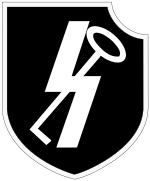| SS Panzer Division “Hitlerjugend” | |
|---|---|
| 12. SS-Panzerdivision "Hitlerjugend" | |
 Unit insignia | |
| Active | 1943–1945 |
| Country | |
| Branch | |
| Type | Panzer |
| Role | Armoured warfare |
| Size | Division 1 November 1943: 14,030[1] 1 June 1944: 20,540[2] 22 August 1944: 12,000[3] 1 November 1944: 21,219[4] 1 February 1945: 19,961[5] 25 April 1944: 6,828[6] |
| Part of | I SS Panzer Corps |
| Patron | Artur Axmann |
| Engagements | |
| Commanders | |
| Notable commanders | |
The SS Division Hitlerjugend or 12th SS Panzer Division "Hitlerjugend" (German: 12. SS-Panzerdivision "Hitlerjugend") was a German armoured division of the Waffen-SS during World War II.[7] The majority of its junior enlisted men were drawn from members of the Hitler Youth, while the senior NCOs and officers were from other Waffen-SS divisions. Most of the enlisted men were teenagers, starting from the ages of 16 or even 15.
The division committed several war crimes while en route to and during the early battles of the Allied Normandy landings, including the Ascq and Normandy massacres, and several massacres, arsons and rapes in the cities of Plomion, Tavaux, Bouillon, Godinne, Hun, Rivere, Warnant and Namur.[8][9] It first saw action on 7 June 1944 as part of the German defensive operations at Caen against Allied Forces, and suffered great casualties during the Battle of the Falaise Pocket.
In December 1944, the division was committed against the US Army in the Ardennes offensive. After the operation's failure, which became known as the Battle of the Bulge, the division was sent to Hungary to participate in fighting around Budapest. The division eventually retreated into Austria and surrendered to the 7th US Army on 8 May 1945. After the war several members of the division, including its former commander Kurt Meyer, were convicted of war crimes.
- ^ 12. SS-Panzer-Division "Hitlerjugend", Ia. Anlage 3 zu Tgb. Nr. 69/43 g.Kdos. Betr.: Monatliche Zustandsbericht. Meldung vom 1 November 1943. Bundesarchiv-Militärarchiv (BA-MA) RH 10/321, fol. 9.
- ^ Zetterling, N. Normandy 1944: German Military Organization, Combat Power and Organizational Effectiveness. Casemate, 2019, p. 311.
- ^ Zetterling, N. Normandy 1944: German Military Organization, Combat Power and Organizational Effectiveness. Casemate, 2019, p. 316.
- ^ 12. SS-Panzer-Division "Hitlerjugend", Ia. Anlage zu Ia Tgb. Nr. 1182/44 g.Kdos. v. 4.11.44. Betr.: Monatliche Zustandsbericht. Meldung vom 1.11.1944. Bundesarchiv-Militärarchiv (BA-MA) RH 10/321, fol. 36.
- ^ 12. SS-Panzer-Division "Hitlerjugend", Ia Tgb. Nr. 108/45 g.Kdos. Betr.: Monatliche Zustandsbericht. Stand: 1.2.45. Bundesarchiv-Militärarchiv (BA-MA) RH 10/321, fol. 52.
- ^ Geheime Kommandosache. Der Verbindungs-Offizier des Reichsführers-SS beim Führer, den 27.4.45. Stärkemeldung der 6. SS-Pz. Armee. 12. SS-Pz. Div. "Hitlerjugend", Stand 25.4.45 Abends. Bundesarchiv-Militärarchiv (BA-MA) RH 10/308, fol. 36.
- ^ Official designation in German language as to "Bundesarchiv-Militärarchiv" in Freiburg im Breisgau, stores of the Wehrmacht and Waffen-SS.
- ^ Cite error: The named reference
:0was invoked but never defined (see the help page). - ^ TV, NatGeo. "National Geographic - Hitler's Teen Killers". www.natgeotv.com. Retrieved 30 April 2024.